
Smontaggio Blue Yeti
Cosa ti serve
Strumenti
Mostra di più…
-
Attrezzo utilizzato in questo passaggio:Tweezers$4.99
-
Per prima cosa rimuovi la gomma all'interno del foro per supporti avvitabili. Puoi riuscirci facilmente usando un cacciavite con una piccola punta di cacciavite o delle pinzette. Dopodiché puoi svitare le tre viti con un cacciavite Philips #1.
-
-
-
I quattro tasti possono essere rimossi semplicemente tirandoli con decisione con le dita o delle pinzette. Noterai che ora c'è parecchio gioco tra la maglia e la scocca.
I’m having trouble removing the volume and mute buttons from the front, much more so than the gain and sound pattern knobs. Is this just me or are all yetis like that?
-
-
-
-
In questo passaggio puoi tirare facilmente, ma attentamente, l'intero corpo del microfono dalla sua scocca. Sul bordo inferiore trovi la porta audio e la porta USB se le devi sostituire.
-
-
-
Se guardi la maglia dal lato della scheda logica, noterai che è tenuta ferma da 4 viti Philips #0. Svitale attentamente e potrai separare l'intera maglia dalla scheda. Ci sono 3 paia di cavi, 1 per condensatore. Noterai che ogni condensatore punta in una direzione diversa, rendendo questo microfono a ripresa laterale e non frontale.
-
-
-
Come mostrato nell'immagine, nella maglia del microfono è presente una schiuma per proteggere i condensatori. I condensatori puntano veri i lati del microfono, rendendolo ottimo per parlarci dai lati e non dalla punta.
You referred to those components as “mic receivers” and “speakers” which is a little confusing since they are neither receivers or speakers. Those are condenser microphones. Thanks.
I made some edits. Hopefully they were meaningful changes to reflect what you said.
The mics don't really point "outward". The mics are not very directional but mostly cardioid to omni-directional. So this is an X-Y configuration (two mics on top of another at 90 degrees angle) that provides the best stereo image or mono if the signals are mixed. So both "front" mics are used for "Stereo" image. All 3 cells are used for "omni" (all signal mixed), Both mics are used for "cardioid" imaging (in mono) with some rejection, maybe, from the back mic. The front mics are also used, in mono, with the back mic, all 3 mixed to offer the "front-back" sound image. The user's best placement is definitely in front of the Yeti for "stereo", "cardioid" and "front-back" imaging. For "omni", it doesn't matter.
-
-
-
Se devi scollegare i condensatori dalla scheda logica, presta attenzione a come sono collegati i cavi.
-
Ci sono 3 condensatori, e quindi 3 paia di cavi collegati alla scheda, ognuno con il loro schema di colori (bianco e nero, rosso e nero, blu e nero).
-
Per rimontare il dispositivo, segui le istruzioni in ordine inverso.
Per rimontare il dispositivo, segui le istruzioni in ordine inverso.
Annulla: non ho completato questa guida.
Altre 31 persone hanno completato questa guida.
Un ringraziamento speciale a questi traduttori:
100%
Questi traduttori ci stanno aiutando ad aggiustare il mondo! Vuoi partecipare?
Inizia a tradurre ›
29 Commenti
And what if i want to do the opposite?
For example, you removed the down part of the yeti, I wanna remove just the top. How can I do that?
You have to remove the bottom to unscrew the top from the inside.
this is a bit of a long shot. but any idea on a replacement part# / source for the 3.5mm barrel jack on one of these?
Try searching on e.g. ebay for “3 pin pcb mount female 3.5mm jack”
The plug is a standard part, so it should be readily available. I replaced my plug with a scavanged part that I happened to have on hand!
Anton -
@ Joe
Sorry I don’t.
Can the internal foam guard be taken out of the microphone mesh, so that they both can be washed, cleaned, and dried separately?
This would be great for those who want to buy a used Blue Yeti microphone.
Lenneurt -
This article answers part of my question:
Lenneurt -
I wouldn’t worry to much about taking the foam out. You will more than likely need to just wash it by running soapy water through it or dumping it into a soap bath and then I would use a fan to dry it.
Lucet. . 28 minutes ago (edited). . I found a video that shows that removing the internal foam from the microphone grill/mesh is possible
Lenneurt -
I have a blue yeti with distorted audio from the mic. Any idea which component may have failed? I'm guessing there's an encoder or amplifier IC on the board which would be a good guess but not too sure on these things
Yeah my Blue just blew I think. The recordings are chopped in half (one of mics is clean). The other sounds clipped/distorted/robotic/digital. So the audio curve is lopsided: the lower half looks correct, the upper half is flattened and nearly dead.
My screwhole on the bottom of the yeti seems too small for the standard screw that comes with the blue radius iii shock mount. I can only tighten the screw 1 turn before it stopes, but there’s still about 6 threads of space… I think I either stripped or compressed the thread tracks because I was an idiot and tried screwing in the wrong screw…
Please help, any ideas to troubleshoot much appreciated
I would suggest taking it apart and try putting the screw into the receiving hole while unbuilt to see if the screw still fits properly with no obstructions. It could be just slightly off when you put it back together causing friction.
Anyone else find their Yeti foam inside the mesh to smell terribly chemical and/or moldy?
I bought mine new years ago and it still has this smell. I spray alcohol and vinegar and the smell comes back
in minutes. I’m thinking it’s just the toxic foam they used on the models ten years ago at least.
Thanks for your help disassembling the mike.
I have a blue yeti with a broken mute button. Looks like a part that can be replaced without soldering if I can find a replacement part, or that there might be something off the shelf that might work. A cylindrical push button with light. Any ideas how to find a replacement part?
I called the company to see if I can purchase the part.
The Microphone repair shops won’t work on anything in that price range.
Blue said they will neither repair the device or sell the part. Shame on them.
Best regards
Do you know the dimensions of the three screws on bottom (length and thread?). I realize one is stripped and two are missing. I emailed Blue and they said they wouldn’t disclose that information. Thanks!
The buttons on there were really tight, had to use pliers to do the job. Completely ruined the buttons, does anyone happen to know places where you could find the replacement buttons on these mics?
EBay has a few spare knobs and buttons, Etsy also has some 3D printed replacements. Hope this helps
Kippler -
Any idea where to get replacement PCB?
Thanks for the guide! My friend broke his mini USB port that I'm currently replacing.
Are you using a standard mini USB port for replacement? I also have a friend that has an damaged mini USB port that needs replacement.
I'll be danged if I can get the buttons and knobs off. Kind of afraid to use vise grips or channel lock pliers. My fingers can't get enough grip on them, and they're "ON THERE." Hmmm...................
Got an iffy phone out volume pot, was going to get in there and squirt the sucker.















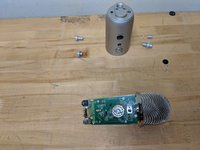
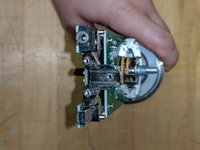


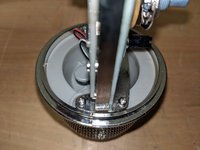
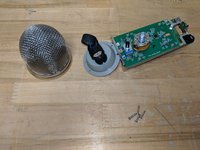



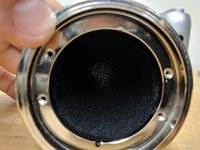
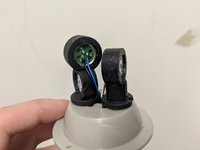
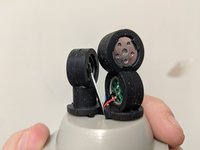


Do you know the measurements of the screws? I was looking to take mine apart to resolder the connections and realized I am missing them. Maybe that’s why my audio crackles.
Ryan Fujimoto - Replica
On black model there is a sticker to remove and 2 of the screws are hidden beneath.
Branden Rush - Replica